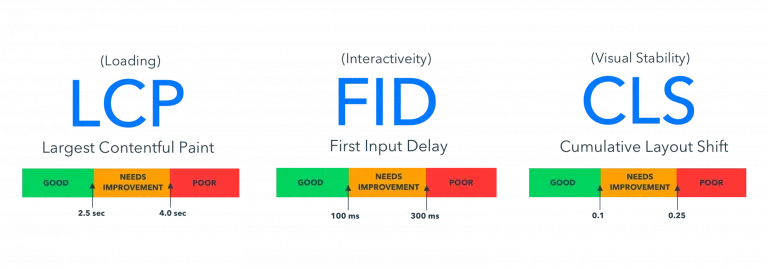History of Google Algorithm Updates
Google’s search algorithms are updated thousands of times per year. Most of these changes are minor. However, “core” updates are sometimes announced well ahead of the rollout to give webmasters the chance to prepare and optimize accordingly.
The easiest way to prepare for and benefit from any Google algorithm update is simply to review Google’s documentation on search engine optimization. Broadly speaking, if you can optimize your site from the outset such that you are producing high-quality content and providing great experiences for users and robots, you will not have much to worry about.
That said, this article will help you better understand some of the most important “core” algorithm updates Google has made over the last decade, how to prepare for the upcoming “Core Web Vitals” update in June 2021, and how to track future updates as they rollout over the rest of the year and beyond.
Table of Contents:
- What is the Google algorithm?
- Frequency of Google algorithm updates
- Major historical algorithm updates
- Most recent algorithm updates
- How to prepare for the June 2021 core algorithm update
- How to stay up to date with Google algorithm updates
WHAT IS THE GOOGLE ALGORITHM?
Google’s algorithms work in a complex system (there are 200+ ranking factors, for example) to answer search queries in the best possible way. Each Google algorithm uses a set of rules, combined with data from its index, to calculate which web pages answer a given search query best, and then the search engine uses its programmed ranking signals to hierarchically organize those pages in search results according to their relevance.

Frequency of Google Algorithm Update
When Google first started, they weren't making nearly as many updates to their algorithm as they are today. Now, Google makes thousands of updates — large and small — every year. Most of them are micro-updates, and webmasters and users are relatively unaffected, but every once and a while Google announces a major algorithm update. These larger algorithm updates are typically events that SEO professionals and webmasters need to plan for. When Google will be making a significant change — or set of changes — to its algorithms, it calls it a "core update" meaning that a core part of the algorithm will change, and it will have a more significant impact on SEO or user experience.
A Short History of Google Algorithm Updates
Here is a list of the major Google algorithm updates over the past 10 years and a short summary of what each meant to webmasters and users.
- Caffeine (2010)
- Panda (2011)
- Penguin (2012)
- Venice (2012)
- Pirate (2012)
- Hummingbird (2013)
- Pigeon (2013)
- HTTPS/SSL (2014)
- Mobilegeddon (2015)
- RankBrain (2015)
- Possum (2016)
- Intrusive Interstitials Update (2017)
- Mobile Page Speed Update (2018)
- Medic (2018)
- BERT (2019)
CAFFEINE INDEX UPDATE (2010)

In June of 2010, Google launched its new Caffeine indexing system. The new indexing system was intended to speed up search results for users and help publishers get their content seen faster.
It helped Google to crawl and store data far more efficiently. According to Google, "Caffeine provide[d] 50 percent fresher results for web searches than our last index, and it's the largest collection of web content we've offered."– Google
This algorithm change was made in an overarching effort to speed up the internet and meet the demand of a rapid-growing web. So, to go along with this overarching mission, Google announced site speed would be a Google ranking signal around the same time.
Impact on SEO:
Although the Caffeine index update didn't include any new ranking factors, the update came as a part of Google's overarching "speed up the internet" initiative which made desktop site speed a new ranking signal and emphasized the importance of website performance.
Caffeine gave users a better experience by enabling Google to index more content across the web.
Panda Update (2011)

The Panda update introduced a new ranking signal which penalized content farms and keyword stuffing as part of Google's mission to serve users quality content. It resulted in improvements to search results by identifying thin, spammy, and low-quality content and then removing it from top search rankings.
Impact on SEO:
Many members of the SEO community had to change their tactics. Black hat SEO tactics like keyword stuffing no longer worked as well and SEOs had to adjust by ensuring that content was really providing value to readers and answers search queries effectively.
Penguin Update (2012)

The purpose of Penguin algorithm update was to target websites that had webspam and used manipulative link building tactics. Google called it the "webspam algorithm update."
Because of this update, the algorithm is now able to identify whether or not the links going back to a certain page are legitimate or are simply spam.
Impact on SEO:
The Penguin update also targeted black hat SEO techniques. Manipulative link-building techniques no longer worked and backlink profiles with a high volume of low-quality links began to see decreases in their organic traffic and rankings.
After Penguin, failure to comply with Google Webmaster Guidelines resulted in ranking penalizations.
Venice (2012)

The Venice algorithm update improved search results for products and services with a closer geographical proximity to the searcher. Searchers could expect to find results from within or very close to their city or town much more reliably. Think of queries like “fitness center near me” or “fitness center Boston”. After this update, the 10 blue links in search results were more likely to serve up local options.
Impact on SEO:
This update had a huge impact on local SEO, especially for smaller businesses and brands. Now, they could compete with bigger businesses and brands for high volume keywords with local intent.
Pirate (2012)

The pirate algorithm update was rolled out to prevent sites with copyright infringement reports from ranking well in Google’s search results. Google recognized that piracy was a big deal, so they cracked down on it by verifying any sites that have been reported for copyright infringement in violation of the Digital Millennium Copyright Act (DMCA).
Impact on SEO:
If your site is in violation of DMCA, and Google is able to verify it, it will be severely down-ranked in organic search results.
Hummingbird (2013)

The Hummingbird Google algorithm update greatly impacted the search engine experience. This update enabled Google to better understand what we call "search intent." It made it so that the search engine was able to contextualize user queries and website information more accurately and connect the two.
Impact on SEO:
The Hummingbird update ultimately made it easier for users to find the most relevant pages to answer their queries. This encourages the search community to better investigate the search intent behind specific keywords and to try to optimize for it.
Pigeon (2013)

The Pigeon Google Algorithm Core Update focused on improving local search. Pigeon was designed to close the gap between Google's local search algorithm and Google's web algorithm in order to improve ranking parameters based on physical proximity.
Impact on SEO:
The pigeon update had a massive impact on the local search community. It made it easier for small businesses to reach a local audience. Now, if small businesses implement basic SEO best practices, — like getting backlinks and growing domain authority — it could improve their chances of ranking.
Additionally, because of Pigeon, it is now more important that small businesses contextualize their business as local in their content, follow local SEO practices like getting local reviews, and implement structured data markup to be easily featured in rich results for local searches.
HTTPS/SSL (2014)

The HTTPS/SSL update was part of Google’s “HTTPS Everywhere” campaign to make the internet more secure and ensure that users were accessing trustworthy and safe websites from their search results. In short, they encouraged webmasters to transfer their websites from HTTP to HTTPS protocols by installing SSL certificates on their website servers.
Impact on SEO:
In this update, Google made HTTPS a lightweight ranking signal and set new user expectations for the level of trust and security in their organic search results.
Mobilegeddon "Mobile-friendliness" Update (2015)

Also known as Google's "mobile-friendly" update, Mobilegeddon came out in April of 2015. This would be the first major update to address Google's "mobile-first" initiative. In order for a page to be considered mobile-friendly, it needs to meet specific visual requirements. Specifically, the proportions need to be conducive to the screen of a mobile device (smartphone).
Impact on SEO:
Mobile-friendliness became a new ranking signal. Web pages that offer mobile-friendly versions of their websites are now prioritized in search results. This only applies to individual pages and not entire websites.
RankBrain (2015)

The RankBrain update introduced new machine learning artificial intelligence to help determine the most relevant search results for a given query. With this update, queries go through an interpretation model that can apply any combination of factors like location and word count to determine intent and deliver the most relevant possible results.
Impact on SEO:
With this update, different ranking signals now apply to different queries. It all boils down to whatever best serves the user’s needs in that query. Optimizing for standard factors is not necessarily sufficient.
Possum (2016)

The Possum update improved local search results. Prior to this update, businesses that fell just outside the physical city limits of a location mightily struggled to rank for associated keywords. This update fixed issues like that. It also made the physical location of the searcher more important, as well as the variations of local terms more sensitive as well.
Impact on SEO:
This was an important local SEO update. Google improved filters based on address and location, measures were taken to diversify results, and spam was further prevented from ranking well.
Intrusive Interstitials Update (2017)
In 2017, Google updated its algorithm to cut down on what's called intrusive interstitials. Intrusive interstitials are essentially large pop-ups. They are ads that cover a large portion of a page and make it more difficult for a user to view the content of a page and find the information they need.
Google explained that the intent of the update was to keep spam at a minimum and enhance SEO, but even if the content has intrusive interstitials, it can still get high search rankings if it effectively answers user search queries.
Impact on SEO:
Due to this update, intrusive interstitials became an SEO ranking penalty.
Mobile Page Speed Update (2018)

In January of 2018, Google posted about a "speed update" to the algorithm that would include new ranking signals which favor pages with fast mobile page speed in mobile search results. This update was a part of both Google's overarching "speed up the internet" initiative and Google's "mobile-first" initiative.
In order to measure fast mobile speed, and get a more accurate representation of the mobile loading experience for real users, Google announced that PageSpeed Insights would now include data from the Chrome User Experience Report and they explained which loading metrics developers and webmasters need to pay attention to. At the time, Google favored First Contentful Paint ( FCP ) and DOM Content Loaded ( DCL ) as two of the most important indicators of a fast loading experience and these metrics could be — this has since changed.
Impact on SEO:
The mobile page speed update made mobile page speed a ranking factor in mobile search results. Sites with really fast mobile pages did better in search results, while pages with slow speeds lost rankings. SEOs need to work with developers or software to solve mobile speed problems.
Medic (2018)

The Medic update improved the identification of expertise, authority, and trustworthiness (EAT) in online content.
Impact on SEO:
There are a number of factors that influence EAT. At the time of this update, if your website had minimal reviews and backlinks, was thin on content, wasn’t updated frequently, or lacked comprehensive profiles of the business and authors of the content, your pages might have been pushed down in search results in favor of links that completed more of this checklist.
BERT Update (2019)

The BERT algorithm (Bidirectional Encoder Representations from Transformers) is a natural language processing machine learning system. It helps a search engine to understand what words in a sentence mean to a human being. The BERT update enables Google to understand search queries more effectively and determine which content is of higher quality, and more relevant to user search queries. After BERT, Google can determine nuance and subtle distinctions of meaning for words based on context.
How does it work? Well, for example, if you say "he's the GOAT" you don't mean he's a farm animal. You mean he's "the greatest of all time." With Google's natural language processing ability, Google would be able to make that distinction.
Impact on SEO:
BERT changes the way SEO copywriters write about topics. Specific keywords become less important and the natural language associated with specific keywords becomes more important. If you are writing quality content on a given topic, giving the correct information, and are in conversation with others who have already written on the topic (citing sources), then the Google algorithm should be able to pick up on that.
Recently Confirmed Google Algorithm Updates
Here is a list of recently publicized major and minor Google algorithm updates over the last couple of years, along with a brief summary of each update's impact on organic search results.
Featured Snippets (January 2020)
The Featured Snippets update deduplicated URLs from search results pages that contained featured snippets. For example, if your web page had gained the featured snippet for a particular query, and was also ranking in the 2nd position with one of the standard blue links, your URL was removed from that listing because Google decided to count Featured snippets as one of the 10 links shown.
Impact on SEO:
Less clicks go to the featured snippet than to the first standard organic listing, for example. So there is valid concern that sites ranking in both or similar positions would experience significant traffic declines from these queries.
Passage Ranking (February 2021)
The Passage Ranking update made it possible for Google to rank specific passages from a web page in search results. This update was motivated by the fact that it was previously hard to satisfy intent from very specific searches, because the answers were often buried deep in web page content. Think of the needle in a haystack analogy here. The solution was for Google to consider the content and meaning of specific passages on a web page when considering the most relevant search results to rank.
Impact on SEO:
Because Google can now pull out sections of your content and rank it independently from the rest of the page, certain forms of on-page SEO become more valuable. For example, header tags further down the page become more important. The same goes for long-tail keywords. Also, there is more incentive to write long-form content because Google is able to parse it better now.
Product Reviews (April 2021)
The Product Reviews update better rewards reviews with in-depth research and analysis from expert and enthusiast publishers. Previously, it was easy for reviews with thin, templated, and summary-based content to rank well in Google search.
Impact on SEO:
Google will not penalize sites with sub-optimal reviews per se. Instead, they will simply rank more thorough review content above these results. In Google’s own documentation on this update, they have provided a list of questions to use when building out reviews. For example, ask yourself if your reviews express expert knowledge, whether they demonstrate how the product is used, how they are different from alternatives, and whether they address key decision-making or purchase factors.
Page Experience (June 2021)

The Page Experience update adds three new Core Web Vitals (Largest Contentful Paint, First Input Delay, and Cumulative Layout Shift) to the Page Experience ranking factor which previously included mobile friendliness, security, safe browsing, and intrusive interstitials. These three new page experience signals measure the loading speed, responsiveness, and visual stability of a website in order to sufficiently measure user experience.
Impact on SEO:
This update penalizes sites that slowly load important above the fold content, are slow to respond to user clicks on buttons and links, and are visually unstable - for example, an ad moves a section of content that you are reading out of place as it loads on screen.
How To Prepare for the June 2021 Google Algorithm Update
In June 2021, Google will be releasing another Core Algorithm Update. The purpose of this update is to improve the user loading experience, which Google refers to as "page experience." The update will include new ranking signals called the Core Web Vitals, which consist of three loading metrics: largest contentful paint (LCP), first input delay (FID), and cumulative layout shift (CLS).
This update is also part of Google's overarching "speed up the internet" initiative and will favor websites that score "good" on these three metrics (though it will still only be one of many ranking factors).
How to Improve Page Speed:
There are many things you can do improve your core web vitals, and each metric requires different solutions and some troubleshooting.
Of course, we recommend using Huckabuy Page Speed software as an automated solution to speeding up your website. We also recommend using a CDN to help with rendering speeds. For information on how to improve each loading metric, click the linked articles above.
How to Keep Up With Algorithm Updates
If you want to keep up with algorithm updates, the best way to do so is to follow Google's major search news outlets like the Chromium blog , the Google Developers blog , and their search-focused Twitter account. Another great resource to learn about algorithm updates is Search Engine Journal
Frequently Asked Questions
How does Google's algorithm work?
Broadly speaking, Google’s ranking systems are made up of a series of algorithms. These search algorithms look at many factors based around the following 5 categories: the meaning of the query, the relevance of web pages, the quality of content, the usability of web pages, and the context and settings to serve up the best possible results. The weight applied to each one of the factors within these categories depends on the nature of the query.
What is Google's latest algorithm update?
The latest core algorithm is set to roll out in June 2021. It is called the “page experience” update and it will penalize sites with poor user experience, measured in terms of the loading speed, responsiveness, and visual stability, as well as whether the site is secure and safe to browse, is mobile friendly, and has a good advertising experience.
How often does Google change their algorithm?
Google updates its algorithm thousands of times per year. Most of the changes are small and go unnoticed by webmasters. Infrequently, Google will announce major “core” algorithm updates and will give webmasters plenty of lead time to prepare accordingly based on the changes that will be rolled out.
Why does Google change their algorithm?
Google is on a mission to organize the world’s information in an accessible and useful way. Their algorithms are getting better and better at providing a great user experience in their search results, but it is a work in progress. Each algorithm update is a step forward in their mission to provide the best possible search results.
What is the best way to prepare for Google algorithm updates?
Broadly speaking, the best way to prepare for Google algorithm changes is to simply focus on producing great content, on a technically sound website, with high-quality external and internal links. If you do this, you won’t have to worry much about upcoming changes. If you are still concerned, the best way to stay updated is to follow Google's major search news outlets like the the Chromium blog, the Google Developers blog, and their search-focused Twitter account. Another great resource to learn about algorithm updates is